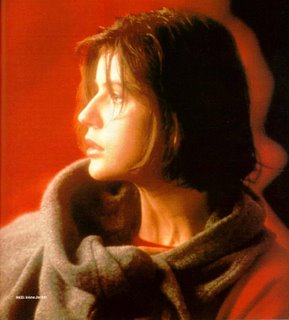
William Carlos Williams, The Red Wheelbarrow.
Larry Clinton, A Study in Scarlet.
Larry Clinton, A Study in Red.
Wallace Stevens, Large Red Man Reading.
Fiona Apple, Red Red Red.
Erik Satie, Suite au Prélude du Rideau Rouge.
Miles Davis, Rouge.
Lionel Hampton, Red Top.
Jan deGaetani and Gilbert Kalish, Ah! May the Red Rose Live Alway.
Joseph Natus, The Fatal Rose of Red.
The Blasters, Red Rose.
Helen Merrill and Charlie Byrd, Scarlet Ribbons.
Peter Gabriel, Red Rain.
Washboard Sam, Red River Dam Blues.
Brownie McGhee and Sonny Terry, Red Cross Store.
Mississippi Fred McDowell, Red Cross Store.

We might as well begin with a pair of red poems and a pair of red studies: the latter performed by Larry Clinton, a late '30s swing band leader now consigned to half-remembered history. Clinton took a lot of stick from jazz critics of the time (viz. Gunther Schuller: “...his pieces all used the same pale, inoffensive instrumental colors, regardless of title...Clinton represented all that was typical–and problematic–of the swing era.”) because he ran a dance band, first and foremost.
That said, Clinton had his ambitions. After hitting with tracks like “Dipsy Doodle” and “My Reverie,” Clinton embarked on a series of compositions he called "studies", the most famous being "Study in Brown" (another was "Study in Surrealism"). Here are Clinton's two studies on red--"Study in Scarlet,” recorded on Bastille Day 1939, is a triumph, a blazing bit of hot swing with a drummer doing his best Gene Krupa; "Study in Red,” from 1938, is not as compelling, though it does feature a piano masquerading as a xylophone, some nice handclaps and a fluttering row of saxophones reminiscent of Clinton's great rival Glenn Miller. Both are on Studies in Clinton.
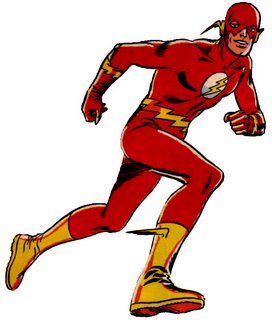
“The Red Wheelbarrow” was published in 1923 by William Carlos Williams (found in Collected Poems); this recording, made in Williams' Rutherford, NJ, house, is from 1954. A note for non-American readers: “The Red Wheelbarrow” is typically the first ‘modern’ poem an American student encounters during her/his education (mainly because of its brevity and its ability to work for any type of criticism under the sun); its reception by students, however, is often not welcoming. A comparable reaction: one time I was on a Queens-bound bus and saw on a “Poetry in Motion” poster, scrawled in pen under a short Ezra Pound poem, "the fuck you talking about”.
“Large Red Man Reading” is from the last years of Wallace Stevens (you can find the poem toward the end of this piece; this recording is from a Caedmon LP from 1957 called, bluntly, Wallace Stevens Reading His Poems); Stevens also wrote, in Notes Toward a Supreme Fiction:
The lion roars at the enraging desert
Reddens the sands with his red-colored noise
Defies red emptiness to evolve his match

Red Room, White House
Another taste of red emptiness: Fiona Apple's “Red Red Red”. Her fivefold repetition of “red” in the chorus grants the word a bit more power, a tinge more desperation, with each dose. This is the take produced by Jon Brion in the earlier, aborted version of Apple's 2005 Extraordinary Machine. (You must know the story—if not, go here.). The official version of “Red Red Red," produced by Mike Elizondo, has arguably a more soulful vocal, but there's a weird intensity to this performance, in which Apple struggles to stop drowning in Brion's overproduction.
The human stain
Red drips from my chin where I have been eating.
Not all the blood, nowhere near all, is wiped off my mouth.
Clots of red mess my hair
And the tiger, the buffalo, know how.
Carl Sandburg, Fight.
One afternoon, as I was entering the New Haven train station, my nose began to bleed copiously. During my late teens and early twenties I suffered regularly from nose bleeds, for reasons I never quite understood, except that it was apparently a by-product of the sinusitis I also endured during those years. And this time it was a gusher--it was as though the lining of one of my nostrils had unraveled--so that I had to dash through the station lobby toward the bathroom, dragging a bag of laundry behind me as though I had just looted a store, all the while cupping my spewing nose with my free left hand.
In the bathroom, I hung my head over the sink and let everything flow for a moment, in the utter relief of having made it to a relative sphere of privacy. And when I opened my eyes again, I saw my blood had spattered the white bowl a bright, vicious, carnal red, the most vibrant red I had ever seen in my life. You can shake in awe of blood when presented so overwhelmingly, you become aware of the power its sight has wielded over the centuries. Seeing bright blood triggers something primal and unsettling, and plays into our own feelings toward red--the bold, merciless warlord of colors.

Vermilion flycatcher
Red is the color of blood and guts: gathered in vials and pints, it indicates prospective life; splattered on a street or battlefield, it signals life’s expiration. (“Scarlet billows start to spread,” goes one line in “Mack the Knife”, as Macheath’s latest victim floats in the canal.)
Red dye, both today and ages ago, is at times derived from actual blood--the lifejuice of crushed insects. The kermes vermilio has been used as a red dye since the time of Moses. Kermes, which are found in the Near East, southern France, Italy and Spain, live on the aptly-named scarlet oak. Roman armies requested kermes dye as tribute, and in the Middle Ages, landlords would accept it as payment for rent. (Kermes is the linguistic root of English words like crimson and carmine.)

cochineal jam
The exploration of North and South America in the 16th Century brought Europeans into contact with the cochineal, which is mainly found in today’s Mexico, Peru and Chile. Cochineal had a long, noble history of serving as a source of red dye for the Incas and Mayans, who treasured the ruby red they could derive from the insect, using it on their faces, walls and textiles. (It takes the corpses of 70,000 insects to make one pound of cochineal dyestuff.)
While red dye derived from insects faded in popularity upon the advent of synthetically-brewed dyes like vermilion (a mixture of sulfur and copper), the puny cochineal has had a resurgence in the past few decades, in part due to growing fear that synthesized dyes possibly contain carcinogens. (A notable case being Red Dye No. 2, which colored a host of red-tinged foods and was banned in the 1970s—-thus my generation grew up believing red M&Ms would kill you.)
In the twenty-first century, women around the world coat their lips with insect blood, we apparently dab our cheeks with it, and in the United States it is one of the few permitted red constituents of eye shadow...Cherry Coke is full of it; it is color additive E120.
So writes Victoria Finlay, in her marvelous travelogue/history Color. Finlay went to a cochineal farm near Santiago, where thousands of rows of prickly pear bushes are grown to serve as temporary hostels for the tiny cochineal, until it comes time for the insects to be swept into bags and either boiled or steamed to death. During her visit, Finlay scoops up a male cochineal, which she describes as a white bedbug-sized creature:
'Squeeze', he said, and I squeezed, and for a moment the creature's hard body resisted, and then it popped like a piece of bubble wrap, leaving a thick dark scarlet stain on my palm.

Red's blood ties have made it a core color of Christianity, the hue of Christ’s sacrifice. For example, the 14th Century mystic Jan van Ruusbroec described in detail the bloody lashing of Christ, of Christ wearing “a cloak lined with fiery scarlet extracted from the blood of worms.”
Perhaps no greater example is Fra Angelico's Christ Crucified With Thorns (c. 1438), in which red saturates Christ's sclerae, it falls in drips on his face, it sings in his lips and tunic. I saw this painting in its recent showing at the Met—it is the only roughly the size of a magazine cover, but it has such a disturbing, gory quality that I had to leave the Angelico exhibit soon afterward. Nothing else seemed remotely comparable to it.

Raphael, Portrait of a Cardinal (c.1510).
Even today, in the Catholic Church, the rubrics, directions in psalters, are written in red, cardinals wear scarlet galeri (large tassled hats), while the pope wears the red tabarro and at times the camauro, his red fur-lined cap that resembles the hat worn by Santa Claus.
The closest to heaven
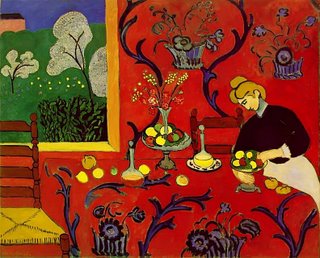
Henri Matisse, Harmony in Red, 1910.
Red is never diluted by reflection. It refuses to be pacified...It is the color of excitement, hypertension and cardiovascular changes, of nervous and glandular activity, of vital force, of the Pentecostal flame, of sex. It is traditionally the color of the upper ether closest to God, from which Satan was expelled, and the color of Mount Scratch himself.
Alexander Theroux, The Primary Colors (whose essay on red is a treasure mine of information).
Red is the long end of the visible spectrum (blood-red sunsets are owed to layers of dust in the atmosphere that absorb the short wavelengths, so the eye only sees reflected reds--and thus a heavily polluted sky will yield the most glorious sunsets). It is perhaps fitting to think that upon leaving the womb, the first thing our eyes take in is a warm red, and that upon our deathbed, the last thing we will ever see is a dwindling red glow.
It is a vibrant, demanding, primary color. To the composer and synesthesiast Alexander Scriabin, red was the natural counterpart of the stalwart, bold key of C major (think of the Beatles' "Can't Buy Me Love," or Mozart's Jupiter Symphony). To Albert Lavignac, red was the color of brass instruments, of clarions and trombones, and in particular, of "the cornet, trivial and braggart, [which] utters a note of very ordinary red, ox-blood, or lees of wine."

sailor's delight
What examples to offer of red music? The riotous circus atmosphere of Erik Satie's "Suite au Prélude du Rideau Rouge (the Prelude of the Red Curtain)", from Satie’s Parade of 1917 (for which Picasso provided sets and costumes)? (Performed here by Maurice Abravnel and the Utah Symphony Orchestra). Or the bright, cool bounce of John Lewis' "Rouge," recorded in 1949 by the Miles Davis Nonet? (On Birth of the Cool.) Or Lionel Hampton's swaggering "Red Top" from 1948, in which even Hampton’s vibes seem tinged with scarlet? (Find here.)
Red lies at the core of seemingly all we see: it was likely the first paint, the color, along with brownish-yellow ocher, most used in primitive art. In the caves of Altamira in Spain are russet images of bison and steer on the ceilings, painted by Cro-Magnons possibly 15,000 years ago. Red's early primacy as a pigment makes sense--it was easy to find (just wetten some reddish earth), and also, when you are painting a wall with the sky, ocean, earth or plantlife all around your work, you're not going to add to the surfeit of blues, browns and greens. Rather, you will choose the brightest red to stand out against nature.
By any other name
O, my Luve's like a red, red rose,
That's newly sprung in June.
O, my Luve's like a melodie
That's sweetly play'd in tune.
Robert Burns.
Red has been embedded in as much symbology as the human mind can fathom. The Egyptians believed it to be the color of death, the desert wastes and Set, the god of destruction; the Jews during their Egyptian interlude painted their doors red to spare them from plagues. It has been the color of magic for most cultures.
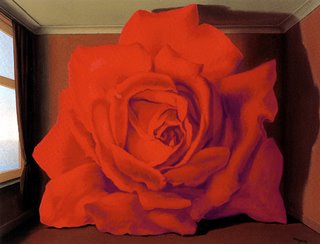
Magritte, La tombeau des lutteurs, 1960
And the red rose has been an age-old symbol of immortality and power, of both purity and desire, ranging from the Greeks (in whose myths Aphrodite, catching her flesh on the thorn of a white rose bush and bleeding, creates the first red rose), to the Romans (the emperor Heliogabalus once dumped so many rose petals upon his guests that he suffocated them), from the Templars (who entwined the rose and the cross), to the doomed House of Lancaster, to the notorious spy Mata Hari, who faced the firing squad with a bouquet of roses in her arms. (Elizabeth I had a fear of roses.)
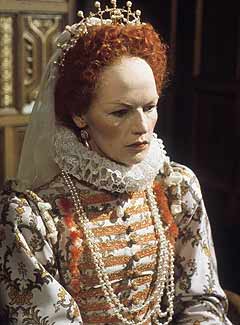
Stephen Foster's "Ah! May the Red Rose Live Alway," a stand against the ravages of time, was written around 1850. It is performed here by the phenomenal Jan deGaetani, whose recordings of Foster’s songs--rendered simply and elegantly, as though in someone's front parlor, without any of the "Americana" schlock that had accumulated around Foster's works--established Foster as the American Schubert he always was. Gilbert Kalish plays an upright piano from the ante-bellum era (if you listen closely, you can hear the wood groan and creak). Recorded in the Hall of Musical Instruments at the Smithsonian Institution in 1972; find on Songs By Stephen Foster.

noonday on the red planet
"The Fatal Rose of Red": A young woman, flush with happiness, accosts an old man on the street walking by with his head hanging down. She asks him why he wears a white rose on his lapel—in response, he grabs her by the shoulders and trembles out his story, while the girl tries to squirm away. It was written in 1900 by J. Fred Helf (also author of the thankfully-forgotten "Every Race Has a Flag Except the Coon") and is performed here on a 1902 Edison recording, sung by Joseph Natus, a rather gruesome popular singer from a century ago. Find in this marvelous archive.
And in the Blasters' "Red Rose," from 1983's Non Fiction, the curse returns, a century later. The Blasters were one of the best things ever to come out of the 1980s: find this track on Testament.

“Scarlet Ribbons” is an example of the pseudo-ancient folk ballad, the sort of standard that one assumes has been around since the Civil War but turns out to only hail from the Kennedy years. In this case, “Scarlet Ribbons” was written in the 1940s by Eveyln Danzig and Jack Segal, and quickly brought into prominence by Jo Stafford and Harry Belafonte. This recording, from 1964, features the melody rendered at its most exquisite by Helen Merrill (with Charlie Byrd on guitar). On The Artistry of Helen Merrill.

Sometimes a red symbol's potency fades with time. Take red neckties. Early in the 20th Century, wearing a red necktie was considered to be a secret signal used by homosexual men in public. Havelock Ellis, a British psychologist, wrote in 1915 of a finding by an anonymous "inverted" (aka gay) "American correspondent":
“It is red...that has become almost a synonym for sexual inversion, not only in the minds of inverts themselves, but in the popular mind. To wear a red necktie on the street is to invite remarks from newsboys and others...Male prostitutes who walk the streets of Philadelphia and New York almost invariably wear red neckties. It is the badge of all their tribe. The rooms of many of my inverted friends have red as the prevailing color in decorations. Among my classmates, at the medical school, few ever had the courage to wear a red tie; those who did never repeated the experiment."
Or in the words of the bitter Jason Compson, in Faulkner's Sound and the Fury, who is sexually obsessed with his niece, Quentin, and who is driven mad by her flirtations with a carnival lothario who wears a red tie: "I'll be damned if they dont dress like they were trying to make every man they passed on the street want to reach out and clap his hand on it. And so I was thinking what kind of a dam man would wear a red tie when all of a sudden I knew he was one of those show folks well as if she'd told me..."
However, by the 1960s, the racy connotations of red neckties began to fade, just around the time of color television. Red neckties became favored among TV anchors and politicians because the red adds subtle color to the face--Bill Clinton and John Kerry often wear red ties, and even Pres. Bush, who favors blue, does so on occasion. The 2004 Republican Convention was described as being a "sea of red neckties", an image that would have given Havelock Ellis a heart attack.
(Trivia note: Jack Kerouac was buried wearing a red bowtie.)
Signs and portents

Or made it like some vile beast, laying it over with
vermilion, and with paint colouring it red, and covering every
spot therein. Wisdom 13:14.
Red is also a color of doom, of warning and danger, of destruction and malevolence. Theroux, in his essay, offers a slew of evidence: The Celts believed red to be the color of death. Doctor Jeckyll's potion is blood red, and Captain Ahab has eyes of "red murder". Nancy Clutter, whose brutal shooting in 1959 was recounted in Truman Capote's In Cold Blood, wrote some of her diary entries in red (she was buried in ruby-red velvet, Capote noted), while Jack the Ripper wrote his letters to newspapers and the police in red ink, including the notorious "From Hell" letter of 1888.
"Red Rain" is the lead-off track from Peter Gabriel's So, which, amazingly, is twenty years old now. (The passage of time can take the breath out of you sometimes). It’s the sort of gorgeous doom epic that Gabriel in his prime could pull off with an effortless majesty; ensconced in an early digital-age cathedral of sound, it has lost little of its power. Sung by Gabriel as if he was the last man on the beach, watching the tide coming in.
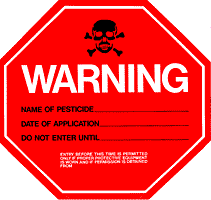
Red is the color of death by flame or chemical spills or high voltage; it is the hue of exit signs that show where we should go if the airplane crashes or the theatre catches fire; it is the top level of the Department of Homeland Security's official panic chart. One of my most vivid childhood scares was reading the "The Sinister Signpost"--one of the more apocalyptic Hardy Boys books, in which the villain is planning to annihilate the boys' hometown, Bayport, by launching a rocket. Entering the villain's grounds, Frank and Joe find the aforementioned sinister signpost, which reads "Death Beyond the Red Hand!"
Death I say, my heart is bowed
Unto thine--O mother!
This red gown will make a shroud
Good as any other!
Edna St. Vincent Millay, The Shroud.
In his swinging 1942 "Red River Dam Blues," Washboard Sam, awash with loneliness, heads to the Red River to meet his end:
I'm gonna build me a scaffold down by Red River Dam
I'm gonna build me a scaffold down by Red River Dam
I may hang myself down there
where people don't know who I am.
Find in Complete Recorded Works Vol. 6.

The sign of the Red Cross typically conveys relief, but not always. In the blues "Red Cross Store," it's a symbol of arrogance and deprivation. "Red Cross Store"'s origins are a mystery--is it an early Depression-era anthem, or does it come out of the 1927 Mississippi flood, which dispossessed a great number of poor Southerners? In any regard, it's an anthem of pride, of dignity, the statement of someone who has had enough mealy charity begrudged to him--something that might have resonance with the dispossessed of Katrina today.
"Red Cross Store" first appears on record in the early 1930s, with versions by Lucille Bogan and Sonny Scott, but Leadbelly's 1940 recording, in which Leadbelly reworked the lyrics (and to make things more confusing, he included some WWI references), seems the most definitive. Sonny and Terry's version, an unreleased take recorded sometime in 1943-1945 (I think 1943) by John Lomax, is fairly topical, with references to Herbert Hoover and Camel cigarettes. On Black Appalachia.
By the time the song was recorded in 1967 by Mississippi Fred McDowell (in a take taped in a dilapidated shack in Como, Missisippi, in between craps games and heavy drinking), all that's left is the taste of gall in the mouth, the fury and lamenting of a scorned man. On Mama Says I'm Crazy.
Deeper into the red

The White Stripes, Red Bowling Ball Ruth.
Tommy James and the Shondells, Crimson and Clover.
Vernon Oxford, Redneck! (The Redneck National Anthem).
Jerry Reed, I'm Just a Redneck in a Rock and Roll Bar.
Teddy Wilson with Billie Holiday, I'm Painting the Town Red.
Eric Clapton, Bottle of Red Wine.
Joni Mitchell, Shades of Scarlet Conquering.
Muddy Waters, Mean Red Spider.
Mary Lou Williams, The Scarlet Creeper.
Sam Cooke, Little Red Rooster.
John Cale, Coral Moon.
The White Stripes' manic "Red Bowling Ball Ruth” is the b-side to the 1999 single "The Big Three Killed My Baby" (SFTRI 578), and is unavailable on CD--that is, until the inevitable 6-disc red- and white-colored boxed set, slated to move in Christmas 2009. Until then, it's a rarity, so enjoy.
And "Crimson and Clover" is from Tommy James and the Shondells' 1969 LP of the same name (with liner notes by Hubert Humphrey). James, far from just being the bubblegum idol the press depicted him as, was also a wildly ambitious producer who, every time the Beatles released a record, would tear up recording studios in an attempt to find out how the band and George Martin had achieved their latest tricks. "Crimson and Clover" is one of James' production triumphs, especially the last chorus, in which James ran pre-recorded vocals from the mixing board into a guitar amplifier, and flipped on the tremolo switch. Find here.
The mean reds
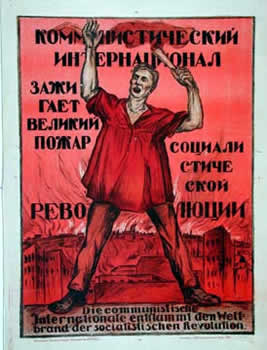
Vkhutemas, 'The Communist International kindles the fire of socialist revolution', 1921
You taught me language; and my profit on't
Is, I know how to curse. The red plague rid you
For learning me your language!
Caliban's rant in The Tempest.
Children's toys and rooms are not generally painted red, for fear the color would agitate them (by contrast, a walk down any supermarket aisle is a journey through every shade of red imaginable, each product screaming for the eye's favor.) And true, throughout history, red has been associated with anger, brutality, with the sort of volatility than can burgeon into revolution and destruction.
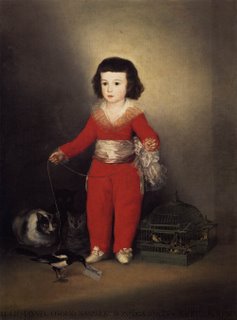
President Bush nicknamed one of his most trusted aides, Joseph Allbaugh, "Pinky" due to Allbaugh's propensity to turn bright red when enraged. But if anyone other than Bush dared to call him by that name, Allbaugh would whirl around and growl, “I will pinch your head off,” and make pinching motions with his fingers.

In the Red Army there are also quite a few people whose individualism finds expression in pleasureseeking. They always hope that their unit will march into big cities. They want to go there not to work but to enjoy themselves. The last thing they want is to work in the Red areas where life is hard.
Mao Tse-tung, "On Correcting Mistaken Ideas in the Party" (later collected in the Little Red Book), 1929.
Red has been the color of leftist revolution in all its incarnations, from the Bolsheviks (whose triumphant architect Lenin is buried in a tomb of red granite) to the Communist Chinese. There was the Japanese Red Army, which hijacked planes and seized embassies until its members began turning on each other, and the Red Army Faction in Germany (AKA the Baader-Meinhof Group), a gang of bank robbers, assassins, kidnappers and occasional revolutionaries. Red seemed the birthright of all 'progressive' movements, so that it seemed doubly appalling when the color got co-opted (say, for example, Fred Smith, the CEO of Federal Express and a notorious union-buster, who allegedly would send out memos relating to breaking unions on red paper so that they couldn't be photocopied.)

But at some point in the past decade, owed mainly to an arbitrary decision by the national television networks, red has fully switched allegiances--it is now the color of Republican America, with all the generalities and cliches that implies (2004 electoral map above).
Sort of like the redemption of the redneck. "Redneck" comes out of the blood of the past, of Scotland during the Covenant, whose supporters would wear red cloth around their necks to signify their allegiance. It's likely the word traveled afterward to America along with thousands of Scotch immigrants in the 18th Century, the immigrants who would settle the backcountry: the deep South and the lower Midwest. It shows up as a derogatory phrase after the Civil War, used in minstrel shows as an insult of the white Southern working class man, and it flourishes in the 20th Century. In Ken Kesey's One Flew Over the Cuckoo's Nest, Randall McMurphy's neck is described as "[coming] out of his t-shirt like a rusty wedge."
By the 1970s, however, as Jimmy Carter began preparing to run for the presidency, with the advent of national fads like CB radio and the growth of professional auto racing, and with the most visible bloodshed of the civil rights movement behind it, the South began to reclaim the word. Here are two early attempts: Vernon Oxford's "Redneck! (The Redneck National Anthem)" is from 1975. On Real Country.
And Jerry Reed's "I'm Just a Redneck in a Rock and Roll Bar," from 1977, offers a similar scenario as Bob Seger's "Old Time Rock and Roll"--the narrator is a guy who just wants to drink beer and listen to old music, but he winds up in some disco with weirdos dancing to The Cars or Chic all around him. But Seger never had lines as good as "there ain't no sexy dresses and there ain't no beehive hair/just boys who look like girls who look like boys who look like Cher." On All American Country.
Stupidly happy

Chagall, Red House (1922)
I am flushed and warm.
I think I may be enormous,
I am so stupidly happy
My Wellingtons
Squelching and squelching through the beautiful red.
Sylvia Plath, Letter in November.
Plath's poem, one of her loveliest, and my favorite of hers, shows that we can't take red too seriously--it is also the color of carnival, of joy and riotous happiness. In China, red is the traditional color of brides, celebrations and good luck; in India, it represents purity. Buddhist monks are clothed in it.
Perhaps red signals the advent of too wild a time. Remember the Star Trek episode "Return of the Archons", in which Kirk, Spock, McCoy and some redshirts beam down to a planet apparently populated by placid dullards who walk around with bemused smiles? Suddenly, however, the clock strikes and so begins the "red hour", when the townspeople begin rioting, screaming, hurling bricks and smashing windows.
"I'm Painting the Town Red" is from 1935, one of Billie Holiday's first-ever recorded performances, with Teddy Wilson's Orchestra (which included at this time a pantheon of jazz gods like Roy Eldridge, Ben Webster and Cozy Cole). Find on Quintessential Vol. 1.
Or drink a "Bottle of Red Wine." Written by Delaney Bramlett, it's from Eric Clapton's self-titled 1970 record, the loosest, happiest thing Clapton ever recorded.
Miss Scarlet in the Conservatory with the Knife
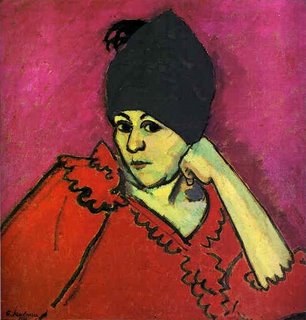
"Please don't wear red tonight," John Lennon sang in "Yes It Is," one of the more obsessive Beatles songs, in which Lennon implores his new girl to stop reminding him of an earlier, lost love, either dead or departed. And red has been long appointed the color of dangerous, seductive women, embodied in the "Lady in Red", Anna Sage, who betrayed John Dillinger, or Hester Prynne with her letter of shame; or Miss Scarlet, who always starts first in a game of Clue, or Alma Garret in Deadwood, who strides through the town wearing a brilliant red dress to indicate that she is out of mourning, and to stake her claim on the town sherrif (who happens to be married).
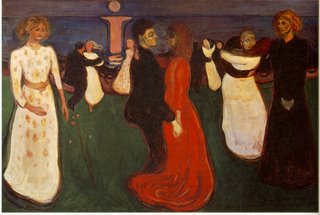
Edvard Munch's The Dance of Life, in which the scarlet lady holds court
"Shades of Scarlet Conquering" is off Joni Mitchell’s 1975 The Hissing of Summer Lawns.
And Muddy Waters' "Mean Red Spider" is from 1948. Contrary to what their name suggests, many species of the spider are actually green, yellow, or orange. On Anthology.
Red has its applications for men as well, generally suggesting someone up to no good. Mary Lou Williams's "Scarlet Creeper" was recorded in 1971 for an LP called From the Heart; it's collected on Nite Life. The title comes from a pimp's name in Carl Van Vechten' s notorious 1926 novel.
There's that in red that warmeth the blood
And quickeneth a man within,
And bringeth to speedy and perfect bud
The germs of original sin.
Eugene Field, Red.
And Sam Cooke's take on Willie Dixon's bawdy "Little Red Rooster" is on 1963's Night Beat, Cooke's most complete LP, featuring a fantastic allotment of session pros, including Barney Kessel on guitar, Hal Blaine on drums, the late Billy Preston on organ and Raymond Johnson on piano.
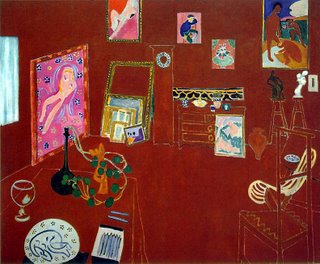
Matisse, The Red Studio
Call it moonrise
This red anathema?
Rise, thou red thing,
Unfold slowly upwards, blood-dark;
Burst the night’s membrane of tranquil stars
Finally.
Maculate
The red Macula.
Hilda Doolittle, Southern Night.
And at last, let the red seep into the dusk. I had a dream a while back in which American Idol (for those unfamiliar with the show, it makes its contestants perform various composer "theme" nights, typically someone like Barry Manilow) had a John Cale night. So Clay Aiken sang "I Keep a Close Watch on This Heart of Mine," the bald rocker guy from the last season sang "Gun." And Katharine McPhee closed out the night with a version of “Coral Moon” that left Simon Cowell in tears. On Cale's 1975 Helen of Troy; find here.
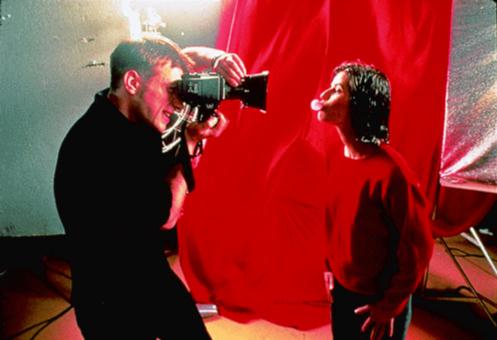
cover star (here and top): Irene Jacob, in Kieslowski's Trois Couleurs: Rouge.
Next:
The count is neither sad, nor sick, nor merry, nor
well; but civil count, civil as an orange, and
something of that jealous complexion.
No comments:
Post a Comment